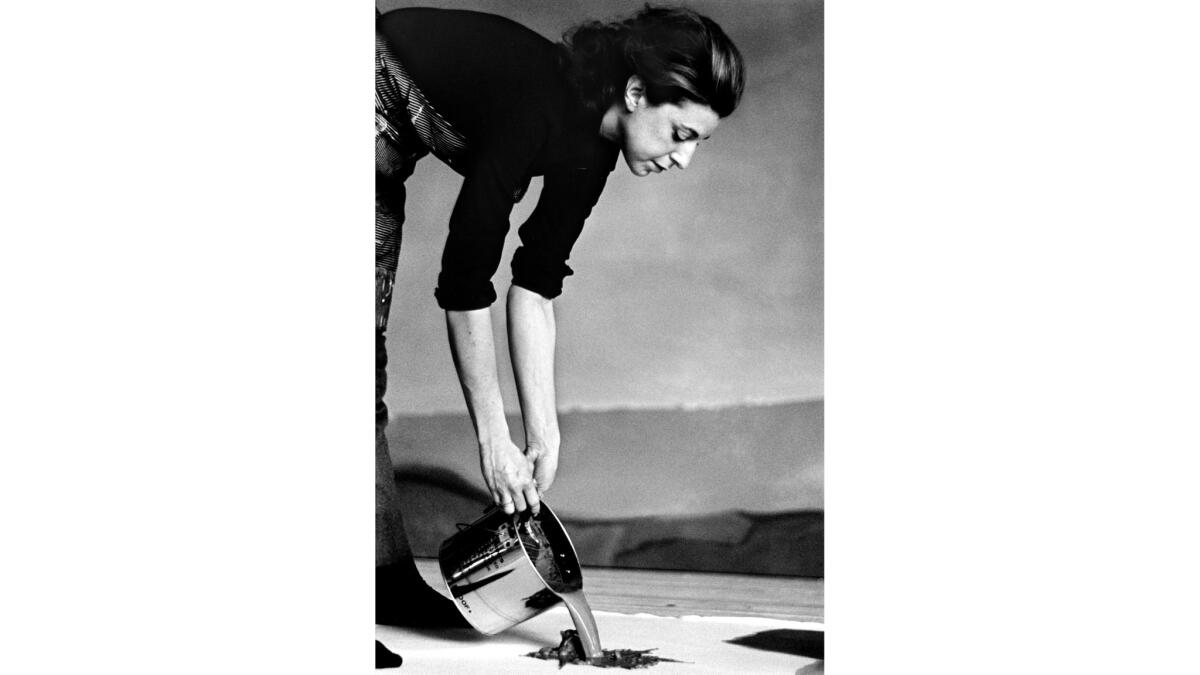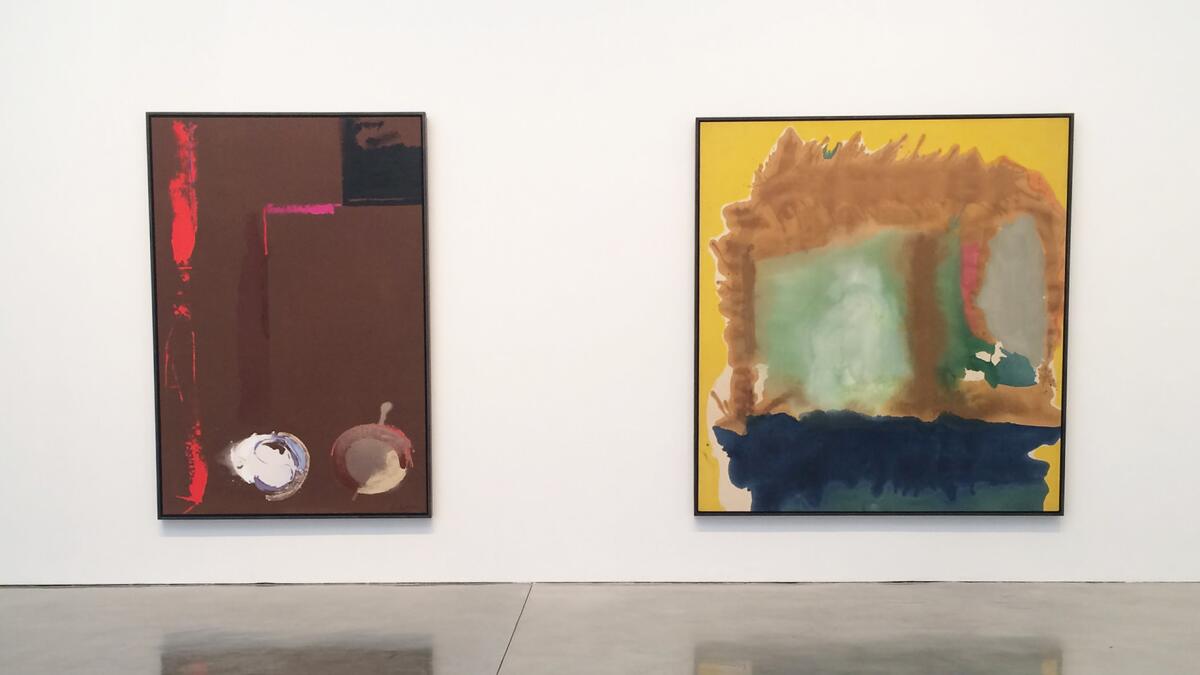Q&A: Pure color: A curator’s new view of Helen Frankenthaler’s unprimed legacy
Helen Frankenthalerâs canvases bare only the sheerest layers of color and paint. Yet with these works the artist straddled two of the most important artistic movements of the 20th century.
She first achieved renown as one of the few female Abstract Expressionists â that rowdy boys club symbolically spearheaded by Jackson Pollock and Willem de Kooning.
For the record:
4:50 p.m. Sept. 16, 2016Update: Additional information was added to the post to clarify the exhibition at which Clement Greenberg met Helen Frankenthaler.
But her innovations with paint â she would often pour thinned paint onto unprimed canvases for work that felt liquid and lush â went on to inspire Color Field artists, who werenât so much interested in using paint as a tool of expression, but in the ways color could be rendered on canvas. (Her 1952 painting, âMountains and Sea,â was a turning point in this direction.)
Now a new exhibition at Gagosian Gallery in Beverly Hills explores some of her later works, from the 1960s to the â80s (she passed away in 2011), works where the painter was exploring the division between drawing and painting.
Curated by John Elderfield, the former chief curator of painting and sculpture at the Museum of Modern Art in New York, âLine Into Color, Color Into Line,â as the exhibition is titled, offers a chance to re-examine works by an artist who doesnât get much air time in Los Angeles. (Frankenthalerâs last solo museum exhibition in the city was at the L.A. County Museum of Art in 1990.)
In advance of the Gagosian show, which features 17 canvases from the holdings of the artistâs namesake foundation in New York, Elderfield sat down for a wide-ranging discussion about the New York artistâs life. In this lightly edited conversation, he discusses her legacy, her very determined character and the unpopular political move that made her a controversial art world figure.
Frankenthaler â along with painter Joan Mitchell and Grace Hartigan â was one of the few women to make a name for herself among the Abstract Expressionists in mid-century New York. How did she become connected to that school of painters?
Through her friendship with critic Clement Greenberg she got to meet all of these people. She had met Greenberg when she was at Bennington College in Vermont. And she got Greenberg to come and look at an exhibition of alumnae work at Jacques Seligmann & Co. gallery in New York, which he agreed to do â if there was booze.
But in New York there was a big division between the boys club and the other people. The Tibor de Nagy Gallery was very open to showing women and was generally more eclectic in how it operated. But none of the big guys showed there at all. Helen was able to be included in some of the group shows which were being organized at the time. She worked hard and was enormously inventive. Her â50s things are quite extraordinary within their time.

What set her work apart from other Abstract Expressionist painters?
It ended up being something which some people found bothersome â and it was because her works were so thinly painted. From âMountains and Seaâ onward, itâs thinly stained paint on canvas.
Compared to De Kooning and Pollock and [Franz] Kline, it was thought that there was something weaker about them because they were more thinly painted. And it was then that there was this sort of equation between these lightly painted pictures and her being a woman (though neither Mitchell nor Hartigan painted in this way). There were some people, like [critic] Harold Rosenberg, who was a big supporter of the idea of the painting being made out of heroic gestures. And with her work there are no gestures.
Her work ended up being quite influential to the Color Field painters â figures such as Morris Louis and Kenneth Noland â whose work was all about the way color sat on a canvas. How did that come about?
Greenberg arranged for Louis and Noland to look at âMountains and Seaâ in 1952 and it started them using thinned-down paint, with the idea that by reducing the kind of tactility of the paint, the color would be more purely color. And they did so in a very abstract way, wherein a kind of drawing persists in Helenâs work, which still had a kind of representational association.
She was a little bit to the side of what these painters were doing. She had a marginal relationship to Abstract Expressionism. She had a marginal relationship to the Color Field painters. She always had to be herself. Thatâs the extraordinary thing about her.
You got to know her while she was alive.
She was fun to be with and a nice person. But she was also, âThis is what I want to do.â She was very clear-minded.
My first contact with her was after Iâd done a show of fauvism at MoMA. She left a note at the information desk saying, âJust saw your show. It was so wonderful, would love to see you.â A couple of days later, the phone rings. Itâs Helen Frankenthaler. She says, âDid you get my note?â I said, âYeah.â She said, âAnd you didnât think to call me?â
She invited me to her studio for a drink. She said, âI just finished reading your catalog for the show. I donât suppose you would want to write a book about me?â I said, âI have a day job. I canât do this.â But 10 years later, thatâs what I was doing.
She had a marginal relationship to Abstract Expressionism. She had a marginal relationship to the Color Field painters. She always had to be herself.
— John Elderfield, curator

The new show you have put together at Gagosian explores the ways in which Frankenthaler employed painting and drawing in her work. What makes drawing and painting different? And what is remarkable about the way she combined them?
The traditional way, of course, is to make a drawing as the basis of a painting, then add color to it.
In âMountains and Sea,â you can see thatâs what she did. There is the drawing, and then the color goes in. But in later works, you see that the color is not shaped by the drawing. Itâs shaped by color. And these two things were of interest to her â to make a painting without a preliminary drawing, but to also find ways of setting down color that reads as clearly as the track of a mark in a drawing.
In a 1990 review of the Frankenthaler survey at LACMA, Times critic Christopher Knight wrote that Frankenthalerâs later works devolved into âdecorative grandiloquence.â You are showing her later works, from 1962 to 1987. What is your response to that conclusion?
I think itâs easy to valorize breakthrough moments and therefore be less interested in things that come later. What one is aware of in Helenâs work is that she is someone who is supremely intelligent about how painting works. Painting is difficult. When someone says, âPainting is dead,â itâs not dead. Itâs just difficult. To work with a traditional medium like this and to find new options in it to my mind is inventive and courageous.
There was a time when nobody had anything good to say about late Picasso. Nothing good at all. Or nothing good to say about Matisse after 1917. Even with CĂŠzanne, there were things that people were very down on â like the bathers pictures. Like, why would someone want to work with such hackneyed subjects?
But you realize later that it doesnât matter. By taking on subjects or mediums which seem to be utterly un-promising, it gives the artist more freedom to work with them.
In the late â80s, Frankenthaler earned the enmity of the art world when, as a member of the National Council on the Arts, she criticized the National Endowment for the Arts for giving grants to Robert Mapplethorpe and Andres Serrano, stating that the organization was âsupporting work of increasingly dubious quality.â Has the art world moved beyond that?
I think she made a big mistake about that and I told her. And she said, âI donât believe artists should be supported in that way.â I said, âHelen, you always had sufficient funds to do what you wanted to do.â It was difficult. Helen was very open and liberal about lots of things, but things related to government stuff, she was just on the other side. It did make it difficult for her among her artistic peers.
I think that it isnât so unusual about artists who are a mixture of liberal and conservative at the same time. CĂŠzanne, for example, was trying to get a petition up to prevent the city of Marseilles from putting up street lights because he felt it spoiled the twilight. And Degas was on the wrong side of the Dreyfus Affair [a 19th century French treason case centered on an anti-Semitic campaign].
How have you seen Frankenthalerâs influence in painters working today?
There are a lot of people, like Lynda Benglis, of course, who is known for pouring on the floor. But Iâve also had surprising people talk to me about her work.
Last year, I wrote an essay about Jenny Saville [known for her towering, expressive figure paintings], and I asked her, âWhose work do you like?â She said to me: âYou knew Helen Frankenthaler. I just loved her work.â And I said, âYou loved her work?â She said, âYes. Iâm trying to paint thinly to achieve greater transparency and I constantly look to her to figure out how she did it.
There are others. [Carroll] âTipâ Dunham, Sue Williams, Kara Walker â a whole range of people.
The preparators here [at the gallery] are all artists. Hanging the show yesterday, there was a couple of them talking. And a painting came out of a box and one of them said, âOmigod, this woman can paint!â
+++
âLine Into Color, Color Into Line: Helen Frankenthaler, Paintings, 1962-1987â
Where: Gagosian Gallery, 456 N. Camden Drive, Beverly Hills
When: Opens Friday and runs through Oct. 29
Info: gagosian.com
Sign up for our weekly Essential Arts & Culture newsletter Âť
Find me on Twitter @cmonstah.
ALSO
The anti-mega gallery: The impromptu shows at Henry Taylorâs living room exhibition space
National Medal of Arts to go to Morgan Freeman, Philip Glass, Luis Valdez
Review: âDoug Aitken: Electric Earthâ: Why MOCAâs big new show has too few sparks
More to Read
The biggest entertainment stories
Get our big stories about Hollywood, film, television, music, arts, culture and more right in your inbox as soon as they publish.
You may occasionally receive promotional content from the Los Angeles Times.











